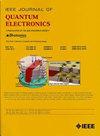二进制4H-SiC nuv增强型SACM apd的设计挑战
IF 2.1
3区 工程技术
Q3 ENGINEERING, ELECTRICAL & ELECTRONIC
引用次数: 0
摘要
近紫外(NUV)盖革模式雪崩光电二极管(NUV- gm - apd)工作在雪崩击穿之上,需要较高的单位增益量子效率(QE)。4H-SiC在UV-C ($\lt 3~\mu $ m厚)中被证明是一种成熟的GM-APD,具有分离吸收电荷倍增(SACM)结构。然而,使用SACM架构来改善NUV单位增益QE具有独特的挑战:包括从现有的前部吸收器SACM架构到非常厚的后部SACM架构。当使用二元半导体材料(例如,4H-SiC)而不是合金异质结构(例如,InGaP或HgCdTe)时,这种情况进一步复杂化,从而消除了可以说是最通用的设计参数,即合金的摩尔分数。为了克服这些挑战,我们已经实现了一个带有校准的4H-SiC材料库的数值模型,用于apd的开发,并利用它来设计nuv增强的SACM结构,其中考虑了非直通(NRT)和直通(RT)架构。对于NRT-SACM的情况,我们确定掺杂谱必须设计成平衡两种竞争机制:最大化吸收层中的少数载流子扩散长度(AL,低AL掺杂时最长),同时最小化AL/电荷层(CL)界面上相应的势垒(高AL掺杂时最低)。相反,在RT-SACM体系结构中,确定了CL中窄范围的总电荷适当地调制了AL中的非零电场,并且在倍增层(ML)中足够大以在雪崩击穿之上运行。因此,确定CL设计异常不耐受层厚度或掺杂的变化。利用本文中学习和报道的设计规则,我们设计了两种类型的SACM架构:NRT-SACM apd和RT-SACM apd,在340 nm处的单位增益QE分别高达32%和71%,同时在ML中保持了盖革模式操作所需的大电场。本文章由计算机程序翻译,如有差异,请以英文原文为准。
Design Challenges in Binary 4H-SiC NUV-Enhanced SACM APDs
Near-ultraviolet (NUV) Geiger-mode avalanche photodiodes (NUV-GM-APD) require high unity-gain quantum efficiency (QE), while operating above avalanche breakdown. 4H-SiC has long been established as a proven GM-APD in the UV-C (<280> $\lt 3~\mu $ m thick) to a separate-absorption charge-multiplication (SACM) architecture. However, using a SACM architecture to improve the NUV unity-gain QE has unique challenges: including deviating from existing front-side absorber SACM architectures to a very thick backside one. This is further compounded when binary semiconductor materials are used (e.g., 4H-SiC) instead of alloyed heterostructures (e.g., InGaP or HgCdTe), removing what is arguably the most versatile design parameter, the mole fraction of the alloy. To overcome these challenges, we have implemented a numerical model with a calibrated 4H-SiC material library for the development of APDs and leveraged it to design NUV-enhanced SACM structures, where both non-reach-through (NRT) and reach-through (RT) architectures have been considered. For the NRT-SACM case, it was determined that the doping profiles must be engineered such that two competing mechanisms are balanced: maximizing the minority carrier diffusion length in the absorber layer (AL, longest at lower AL doping), while minimizing the corresponding potential barrier at the AL/charge layer (CL) interface (lowest at higher AL doping). Conversely, in a RT-SACM architecture, it was determined that a narrow range of total charge in the CL properly modulated the electric field to be non-zero in the AL and sufficiently large in the multiplication layer (ML) to operate above avalanche breakdown. As such, it was determined that the CL design is exceptionally intolerant to variations in either layer thickness or doping. Leveraging design rules learned and reported in this paper, we have designed both types of SACM architectures: NRT-SACM APDs and RT-SACM APDs, with unity gain QE at 340 nm up to 32% and 71% respectively, while maintaining a large electric field in the ML required for Geiger-mode operation.
求助全文
通过发布文献求助,成功后即可免费获取论文全文。
去求助
来源期刊

IEEE Journal of Quantum Electronics
工程技术-工程:电子与电气
CiteScore
4.70
自引率
4.00%
发文量
99
审稿时长
3.0 months
期刊介绍:
The IEEE Journal of Quantum Electronics is dedicated to the publication of manuscripts reporting novel experimental or theoretical results in the broad field of the science and technology of quantum electronics. The Journal comprises original contributions, both regular papers and letters, describing significant advances in the understanding of quantum electronics phenomena or the demonstration of new devices, systems, or applications. Manuscripts reporting new developments in systems and applications must emphasize quantum electronics principles or devices. The scope of JQE encompasses the generation, propagation, detection, and application of coherent electromagnetic radiation having wavelengths below one millimeter (i.e., in the submillimeter, infrared, visible, ultraviolet, etc., regions). Whether the focus of a manuscript is a quantum-electronic device or phenomenon, the critical factor in the editorial review of a manuscript is the potential impact of the results presented on continuing research in the field or on advancing the technological base of quantum electronics.
 求助内容:
求助内容: 应助结果提醒方式:
应助结果提醒方式:


